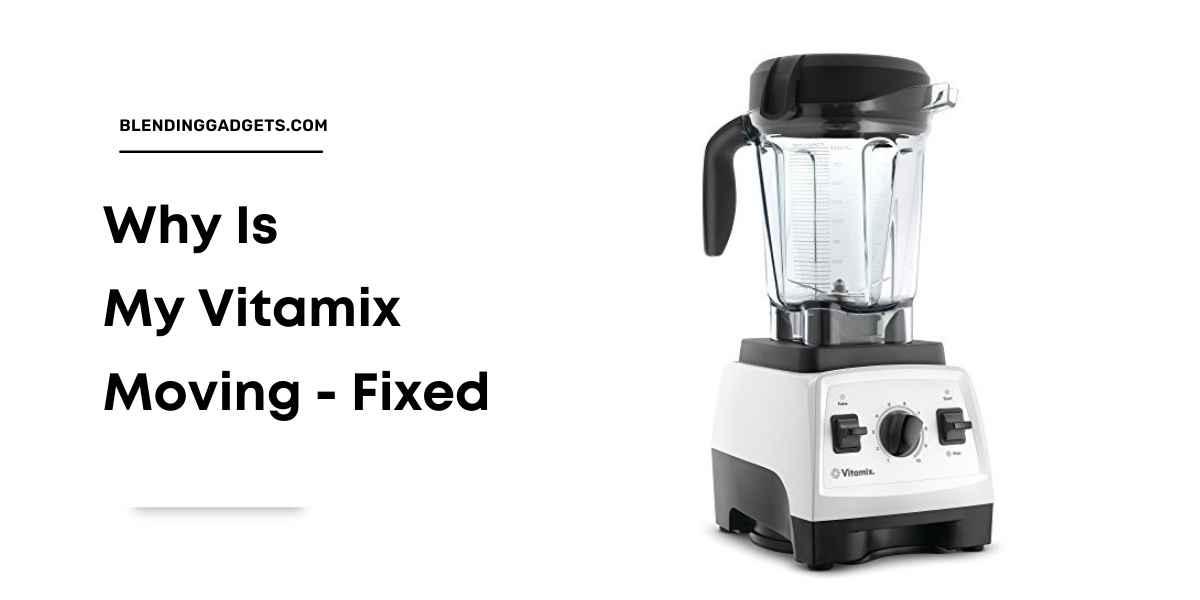Vitamix blenders have earned a reputation as a kitchen workhorse, capable of blending, pureeing, and processing a wide variety of ingredients to perfection. However, even the most reliable kitchen appliances can occasionally encounter hiccups, and one common issue users face is the unexpected movement or vibration of their Vitamix blender during operation.
This perplexing problem can not only disrupt the blending process but also raise concerns about safety and overall appliance health.
In this article, we delve into the reasons behind the unsettling movement of your Vitamix blender and provide practical solutions to help you restore stability to your culinary endeavors. From exploring countertop grip and ingredient quantities to examining blade assembly and motor base problems, we aim to unravel the mysteries of blender movement and equip you with the knowledge needed to fix and prevent this issue.
Whether you’re a seasoned Vitamix user or a newcomer to the world of high-performance blenders, understanding why your Vitamix is moving and how to address it will ensure your blending experiences are smooth, efficient, and frustration-free.
Why Is My Vitamix Moving And How To Fix It

There are a few reasons why your Vitamix might be moving around on your counter.
1. Insufficient Counter Grip
Understanding the Significance of Counter Grip
A stable countertop is not just a mere surface to place your appliances upon; it’s the foundation upon which your culinary creations come to life. The counter grip plays a vital role in maintaining the stability of your Vitamix blender. When there’s insufficient grip between the blender’s base and the countertop, even the mighty power of the Vitamix motor can set it in motion, resulting in unwelcome movement and vibrations.
Causes of Insufficient Counter Grip
- Surface Material: Different countertop materials offer varying degrees of grip. Smooth surfaces like glass or polished granite might allow the blender to slide due to their reduced friction. On the other hand, materials with textured surfaces, such as natural stone or certain laminates, provide better resistance against movement.
- Weight and Power: The power-packed motor of a Vitamix generates significant force during operation. If your blender is lightweight or the countertop is unable to counteract this force, the blender might start to move.
- Surface Condition: Small imperfections or particles between the base of the blender and the countertop can hinder proper grip, making movement more likely.
Solutions for Ensuring Counter Grip
- Choose the Right Location: Place your Vitamix on a countertop with a textured or slightly rough surface. This will enhance the grip and minimize the chances of movement.
- Anti-Slip Mats: Consider using anti-slip mats or liners designed to be placed under appliances. These mats provide an extra layer of grip, preventing unwanted sliding.
- Damp Cloth or Towel: Placing a damp cloth or towel beneath the blender can increase friction and stabilize the appliance.
- Rubber Pads or Feet: Some blenders, including certain models of Vitamix, come with rubber feet that improve grip. If your blender doesn’t have these, you can purchase adhesive rubber pads to attach to the base.
2. Uneven Surface: Keeping Your Vitamix on Solid Ground
Imagine blending a batch of your favorite smoothie only to find your Vitamix wobbling or vibrating across the counter as it whirrs. This unsettling sight often arises from an unexpected culprit: an uneven countertop surface. In this section, we’ll delve into the impact of an uneven surface on blender stability, explore the causes, and provide you with practical solutions to ensure your Vitamix stays put during operation.
Understanding the Role of Surface Leveling
A smooth and even countertop surface is essential not only for maintaining the aesthetics of your kitchen but also for ensuring the stability of appliances like your Vitamix blender. An uneven surface can lead to imbalance, causing your blender to move or vibrate, and potentially resulting in uneven blending or spillage.
Causes of an Uneven Surface
- Settling and Movement: Over time, countertops can settle, causing slight slopes or unevenness. Additionally, frequent movement of heavy appliances can lead to the countertop becoming unlevel.
- Installation Issues: Improper installation of countertops or inadequate leveling during construction can contribute to an uneven surface.
- External Factors: Factors like temperature changes, humidity, and the type of countertop material can cause slight warping or unevenness.
Solutions for Ensuring Surface Leveling
- Leveling Adjustments: If your countertop is adjustable, ensure that it is properly leveled. Use a leveling tool to identify any discrepancies and make necessary adjustments.
- Shims or Supports: Underneath the countertop, use shims or supports to raise or lower specific areas, achieving a more even surface.
- Professional Assistance: If you suspect significant settling or installation issues, consider seeking professional help to ensure your countertop is properly leveled.
- Using Adjustable Blender Feet: Some blenders, including certain models of Vitamix, come with adjustable feet. Adjusting these feet to match the unevenness of the countertop can help stabilize the blender.
Preventing Future Unevenness
- Even Weight Distribution: Try to avoid concentrating heavy items in one area of your countertop, as this can contribute to uneven settling.
- Regular Maintenance: Periodically check your countertop for any signs of unevenness. Address any minor settling or movement promptly to prevent larger issues.
3. Overloading the Blender: Finding Balance for Optimal Blending
The unmistakable power of a Vitamix blender is a kitchen marvel, capable of turning even the toughest ingredients into velvety concoctions. Yet, when this powerhouse appliance starts to move or shake during operation, it might not be due to its strength, but rather due to your enthusiasm for loading it beyond its capacity. In this section, we explore the consequences of overloading your Vitamix, uncover the reasons behind it, and provide solutions to keep your blending experiences both satisfying and stable.
Understanding the Perils of Overloading
It’s tempting to throw a multitude of ingredients into your Vitamix, capitalizing on its incredible capabilities. However, pushing your blender beyond its limits can lead to performance issues, including movement or vibrations. Overloading can strain the motor, throw off the balance, and undermine the blending process.
Causes of Overloading
- Exceeding Capacity: Every Vitamix model comes with a specified blending capacity. Overloading occurs when you surpass this limit, placing undue stress on the motor and components.
- Improper Layering: Poorly layering ingredients, especially dense ones, can cause uneven weight distribution, leading to an imbalance that triggers movement.
- Insufficient Liquid: Blending without adequate liquid can result in a thick mixture that’s difficult for the blades to process, causing the blender to struggle and move.
Solutions for Avoiding Overloading
- Follow Capacity Guidelines: Familiarize yourself with your Vitamix’s capacity limits. Refer to the user manual for specific guidelines on ingredient quantities.
- Proper Layering: Layer heavy and dense ingredients closer to the blades and lighter ones on top. This maintains a balanced weight distribution, reducing strain.
- Adequate Liquid: Ensure there’s enough liquid to facilitate smooth blending. Start with the recommended liquid amount, adjusting as needed.
- Pause and Pulse: If blending a thick mixture, use the “pulse” function intermittently to prevent strain on the motor. This allows the blender to catch up and prevents excessive movement.
Preventing Future Overloading
- Pre-Cutting Ingredients: Chop larger ingredients into smaller pieces before blending. This eases the strain on the motor and promotes even blending.
- Layer Wisely: Practice thoughtful ingredient layering in your blender, maintaining a balance between heavy and light components.
Related Posts
Final Thoughts
Your Vitamix blender is a culinary workhorse, capable of turning raw ingredients into exquisite creations with the push of a button. However, if you’ve encountered the frustrating issue of your Vitamix moving or vibrating during operation, it’s important to address the underlying causes for a seamless blending experience.
From countertop grip and even surfaces to blade assembly, jar issues, and motor base problems, each aspect plays a vital role in ensuring stability and precision.
By understanding the significance of proper countertop grip, avoiding overloading the blender, securely assembling blade components and jars, and maintaining a balanced motor base, you can conquer the challenge of unwanted movement during blending.
Respect your Vitamix’s capacity limits, follow assembly guidelines, and practice routine maintenance to ensure that your blending experiences are not only efficient but also safe and enjoyable.
Remember, a stable Vitamix doesn’t just lead to smoother blends; it safeguards the appliance’s performance and longevity. With the insights and solutions provided in this article, you have the knowledge to troubleshoot and overcome the issues that might arise, enabling you to harness the full potential of your Vitamix and create culinary masterpieces with confidence.
So, the next time you power up your Vitamix, rest assured that you’re armed with the understanding and solutions needed to keep it steady, vibrant, and ready to elevate your culinary endeavors to new heights. Happy blending!


